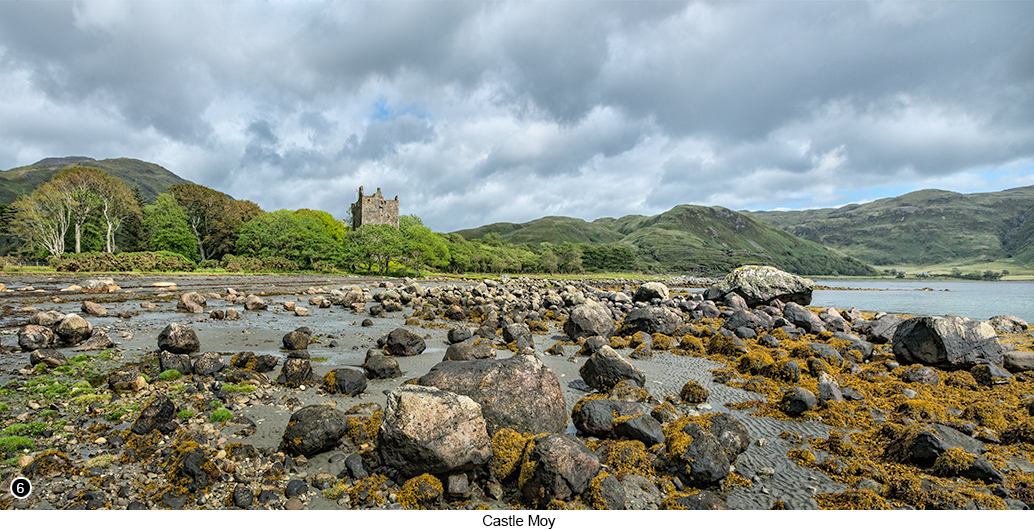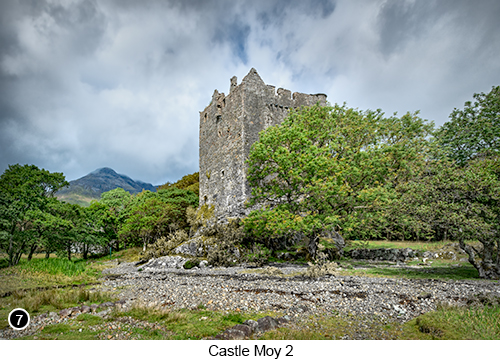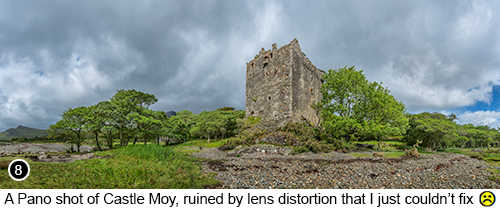

Lochbuie (the Village) on Loch Buie (the Loch) situated on the Isle of Mull - (Part 2) Featuring a very photogenic partially ruined Castle built in 1494, sitting right on the edge of a sweeping boulder strewn bay |
|
Setting The Scene - Moy Castle was built by the local MacLaine Clan in the mid 1400's and as with all castles in Scotland it seems, has a very troubled history associated with it, as well as being the source of many strange stories about the people would lived there. For example, in 1538 the current owner was called "Ewen of the Little Head" and who managed to get himself killed during a feud with the locals that his wife had started. So even though he was called "Ewen of the Little Head", he obviously wasn't very good at keeping it out of harms way enough to avoid someone hacking it off during the ensuing battle to protect her reputation. But even then he was still able to hang on tightly to the reins of the horse he was riding, which galloped away at full speed for two miles, before his headless corpse finally let go of the reins and he fell to the ground. As a result it is said that even to this day, his headless corpse can still be seen riding through the glen draped in a cloak of green, but only when a member of the MacLaine family is about to die. Then many years later when the castle was being occupied by another difficult member of the MacLaine family called "Ian the Toothless" (I mean you really can't deny that they knew how to give people highly descriptive and very none PC nicknames back in the old days can you?), who was then abducted by another wing of the MacLaine family from Duart, because they had grown tired of him constantly giving their clan a bad name with his debauched lifestyle and who then chose to imprison him on the tiny Isle of Cairnburgh which they also owned, but with only (and I quote) "an ugly old women for company", to make sure that he couldn't produce any offspring that could later claim back ownership of the castle and of course whom he then promptly |
 |
|
managed to get pregnant. So the Duart members of the family having heard of this amazing feat of over aged impregnation, decided that the only way to prevent him from producing this up and coming heir to the ownership of the castle and who would then have every reason to take it back off them with force as soon as he could, was to quietly murder them all on the isle. But by the time they arrived there, the old (yet pregnant) woman had been tipped off they were coming when she'd visited the mainland to stock up on supplies and who then made her escape long before they arrived. So when they did finally get onto the Isle and found Ian the Toothless sitting there on his own, they must have thought something like "Oh what the heck" in Gaelic and murdered him anyway. However, they were still unable to track down the fleeing old woman, or stop her producing his male heir several months later and who then became known as "Murdoch the Stunted" and who was indeed able to eventually wrest back ownership of Castle Moy from the Duart MacLaines many years later. How to get there - Moy Castle - Street View 1 - Map View. Continue walking along the edge of the coast away from the car park and then on past St Kilda's Church (as discussed in Part 1 of this chapter) on your left. Then continue on along the track for another couple of hundred yards or so, until you see a gate on your right that faces towards the sea. Walk through the gate (making sure you close it again afterwards) and follow the path as it turns immediately to your left and then goes around the base of a small grassy hillock, until you see the bay view opening up in front of you, as shown in shot 5 above but from the opposite end of the beach. |
 |
|
You should now have a good view of the old partly ruined castle at the opposite end of the beach and if you are here at low tide, which I suggest you are, then you should also be able to get a similar shot of the old castle using a cropped single shot pano as shown in shot 6 above. But also try to frame your shot, so that it encompasses as many of the larger boulders nearest to the sea as possible. This way you can add in lots of foreground interest, as well as using the receding size of the boulders to act as a series of lead in lines, that will then lead the viewers eye all the way across the bay towards the castle and then back around to the boulders again. If you then walk across the beach to the castle, you will then have quite a few more close up compositions and angles from which to shoot it, as shown in shot 7. But by the time I got around to taking the series of shots for the pano shown below in shot 8, it had started to rain again, so I knew that by the time I'd set up my tripod the shot would be gone. So instead I decided to hand hold my camera and quickly fire off a series of horizontal shots close into the castle. However I obviously wasn't thinking straight and forgot how much of a big and unrepairable mistake I was making by doing this and one that I should have known better not to do. You see when standing really close into a subject and using a very wide angle lens as I found myself doing for this multi shot pano, I already knew that if I shot the scene horizontally using the widest part of the lens, that when it came to stitching the files back together, it would make any vertical structures such as the turret of the castle, look like it was falling away from me due to a form of wide angle lens distortion that is pretty much impossible to correct in a multi shot pano. So what I should have done (and what I have done so many times before under similar circumstances, so why I didn't do it here is beyond me), was instead of taking each shot horizontally, I should have taken them vertically. This way I would then be using the narrowest aspect ratio of the lens and therefore the least distorted part of it for each shot. Then when it came to stitching them all back together again, I could have done so without any noticeable distortion across the entire width of the shot. So in hindsight I suppose the only reason why I shot it wide and so badly, was that I must have thought "Oh dear, it's starting to rain heavily, so I have to rush this series of pano shots before the rain stops me". But what I should have done, was to admit defeat and put the camera away and seek shelter under a tree for a while, as I looked up at the clouds to see if there was any chance of a gap in the rain, before I then went back out to shoot it properly and if there wasn't going to be a gap, then I should have just chalked it up as Mother Nature 1, Dave Hickey unknown landscape photographer 0. |

|
|
 |
|
I also took a couple of shots of the notice board found near to the front of the castle and which displays lots more historical information about how it was originally constructed and who were the most notable owners of it over the many hundreds of years it has been there. |
|
--Exif information for each of the numbered shots shown throughout this chapter --5 - Canon EF16-35/2.8L USM, 1/250th Sec, f/16, ISO 200, Focal Length 21mm, taken on 28th Aug at 12:22 --7 - Canon EF16-35/2.8L USM, 1/250th Sec, f/16, ISO 320, Focal Length 16mm, taken on 28th Aug at 12:19 --8 - Canon EF16-35/2.8L USM, 1/250th Sec, f/16, ISO 320, Focal Length 16mm (3 shot horizontal pano), taken on 28th Aug at 14:14 |
|
If you have enjoyed reading these 'Extra' chapters to my Guide Book and think you might also enjoy reading 79 more chapters across 270 pages, that also includes more than 340 Fine Art quality images, along with detailed descriptions and large scale maps to guide you to the exact location of where I took each and every one of them and which then goes onto discuss the techniques and tools I used to process them, but where everything is written in plain easy to understand English? Then please consider buying the Book. |
|